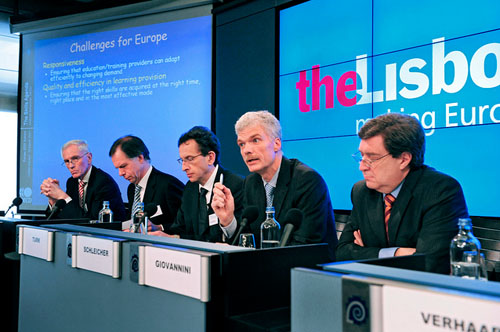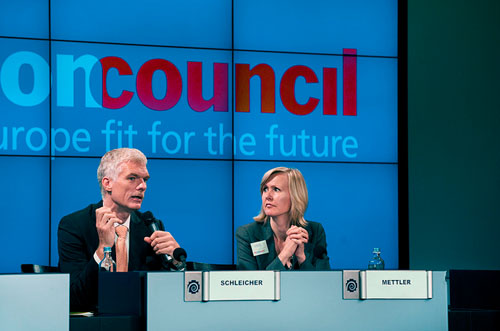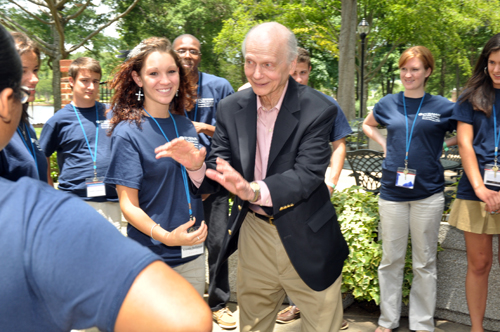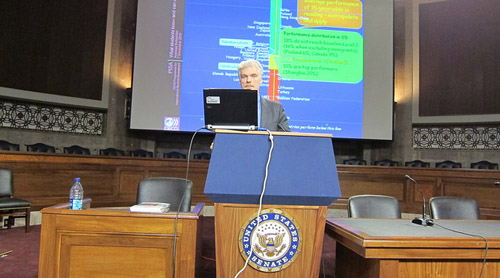
According to Andreas Schleicher of OECD, the United States is unique among countries in that the generation of workers entering the US workforce does not have higher college attainment levels than the generation about to leave the workforce. He further believes a key strategy to addressing this problem is improving equitable access to education across the board and that good examples of how to achieve this can be found in other education systems such as Finland, Canada, Japan or Korea. None of this sounds particularly new, but I wondered if Andreas were making the big picture education decisions, how would he address some of our key issues? We recently had the opportunity to discuss this further.
Andreas Schleicher is Special Advisor on Education Policy to OECD’s Secretary-General, and is Deputy Director for Education. He also provides strategic oversight over OECD’s work on the development and utilization of skills and their social and economic outcomes. This includes the Programme for International Student Assessment (PISA), l'indagine OCSE di abilità per adulti (PIAAC), la e l'apprendimento dell'OCSE Internazionale Survey (TALE), e lo sviluppo e l'analisi di benchmark sulle prestazioni dei sistemi d'istruzione (INES).

Qualora il governo fornire lezioni istruzione gratuita dalla scuola materna attraverso l'università?
Non vi è alcuna istruzione gratuita; someone has to pay. If governments provide free education from pre-school through college, they need to back that up with a steeply progressive tax system so that the better qualified people end up paying the bill eventually. The Nordic countries in Europe show that this can work, and work well. The other good option is to ask students to pay tuition and to back that up with a universal student support system that provides an income-contingent loan system complemented with a scheme of means-tested grants. In that way you minimize risks for students, avoid that they end up with huge debt that they cannot pay back, and you provide special assistance to those students who would otherwise be prevented from attending university. The UK shows how this can work. Providing college tuition-free without getting the money back through taxes for the better-educated means that the poor end up subsidizing the education of the rich.
Are you in favor of privatizing public schools?
Results from PISA show no performance advantage of private schools, once you account for social background. Tuttavia, cross-country analysis of PISA suggests that the prevalence of schools’ autonomy to define and elaborate their curricula and assessments relates positively to the performance of school systems, even after accounting for national income. School systems that provide schools with greater discretion in deciding student assessment policies, the courses offered, the course content and the textbooks used are also school systems that perform at higher levels. So perhaps the question for countries is not how many private or charter schools they have, but how they enable every public school to assume charter-type responsibility.

Since every child is probably not meant to pursue a liberal arts education, what would you do to make our children more competitive in the skilled trade jobs market?
Our data show that when employers are involved in designing curricula and delivering education programs at the post-secondary level, students seem to have a smoother transition from education into the labor market. Compared to purely government-designed curricula taught in school-based systems, learning in the workplace offers several advantages: it allows trainees to develop “hard” skills on modern equipment, e “soft” competenze, such as teamwork, communication and negotiation, through real-world experience. Hands-on workplace training can also help to motivate disengaged youth to stay in or re-engage with the education system. Workplace training also facilitates recruitment by allowing employers and potential employees to get to know each other, while trainees contribute to the output of the training firm. Workplace learning opportunities are also a direct expression of employers’ esigenze, as employers will be ready to offer opportunities in areas where there is a skills shortage.

Do you think that the United States needs to do more in the area of early childhood education, e se così fosse, che cosa?
One the one hand, the US falls well behind most countries in the industrialized world when it comes to early childhood education, and this is clearly a key lever to raise quality and equity in learning outcomes. Contemporaneamente, gli Stati Uniti fanno davvero bene quando si guarda il rendimento degli studenti nella scuola primaria, così così quando si tratta di prestazioni nella scuola media, e non molto bene quando si tratta di prestazioni al liceo. Questo suggerisce che gli studenti effettivamente ottenere un bel buon inizio, ma il sistema scolastico aggiunge meno anno dopo anno di quello che i bambini in altri paesi imparare. Questo è qualcosa che non affrontare con una migliore educazione della prima infanzia, ma con un sistema di scuola migliore.
Cosa pensi sia il modo migliore per finanziare le nostre scuole pubbliche?
Gli Stati Uniti spendono un sacco di soldi per le scuole pubbliche, ma i nostri dati mostrano tre cose. Prima di tutto, una quota sproporzionatamente elevata di tale spesa non rende in classe. In secondo luogo, la spesa è regressiva in che le scuole in zone svantaggiate finiscono con meno risorse di scuole in aree socialmente svantaggiate (in quasi tutti gli altri paesi industrializzati, è il contrario). This does not allow the US to attract the most talented teachers into the most challenging classrooms, which would make public spending most effective. Terzo, high performing countries tend to prioritize the quality of teachers and the size of classes. The trend in the US over the last decade has gone the other way around.

Photos courtesy of OECD.
Nel Global Search per l'Educazione, unirsi a me e leader di pensiero di fama mondiale tra cui Sir Michael Barber (Regno Unito), Dr. Michael Block (Stati Uniti), Dr. Leon Botstein (Stati Uniti), Il professor Argilla Christensen (Stati Uniti), Dr. Linda di Darling-Hammond (Stati Uniti), Dr. Madhav Chavan (India), Il professor Michael Fullan (Canada), Il professor Howard Gardner (Stati Uniti), Il professor Andy Hargreaves (Stati Uniti), Il professor Yvonne Hellman (Paesi Bassi), Il professor Kristin Helstad (Norvegia), Jean Hendrickson (Stati Uniti), Il professor Rose Hipkins (Nuova Zelanda), Il professor Cornelia Hoogland (Canada), Onorevole Jeff Johnson (Canada), Sig.ra. Chantal Kaufmann (Belgio), Dr. Eija Kauppinen (Finlandia), Segretario di Stato Tapio Kosunen (Finlandia), Il professor Dominique Lafontaine (Belgio), Il professor Hugh Lauder (Regno Unito), Il professor Ben Levin (Canada), Signore Ken Macdonald (Regno Unito), Il professor Barry McGaw (Australia), Shiv Nadar (India), Il professor R. Natarajan (India), Dr. PAK NG (Singapore), Dr. Denise Papa (Stati Uniti), Sridhar Rajagopalan (India), Dr. Diane Ravitch (Stati Uniti), Richard Wilson Riley (Stati Uniti), Sir Ken Robinson (Regno Unito), Professor Pasi Sahlberg (Finlandia), Andreas Schleicher (PISA, OCSE), Dr. Anthony Seldon (Regno Unito), Dr. David Shaffer (Stati Uniti), Dr. Kirsten Immersive Are (Norvegia), Cancelliere Stephen Spahn (Stati Uniti), Yves Theze (French Lycee Stati Uniti), Il professor Charles Ungerleider (Canada), Il professor Tony Wagner (Stati Uniti), Sir David Watson (Regno Unito), Professor Dylan Wiliam (Regno Unito), Dr. Mark Wormald (Regno Unito), Il professor Theo Wubbels (Paesi Bassi), Il professor Michael Young (Regno Unito), e il professor Zhang Minxuan (Porcellana) mentre esplorano le grandi questioni educative immagine che tutte le nazioni devono affrontare oggi. Il Global Ricerca per l'Educazione della Comunità Pagina
C. M. Rubin è l'autore di due ampiamente lettura serie on-line per il quale ha ricevuto una 2011 Premio Upton Sinclair, “Il Global Ricerca per l'Educazione” e “Come faremo a Leggere?” Lei è anche l'autore di tre libri bestseller, Compreso The Real Alice in Wonderland.
Segui C. M. Rubin su Twitter: www.twitter.com/@cmrubinworld






Commenti recenti